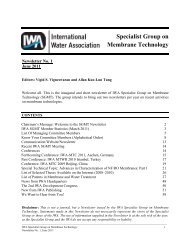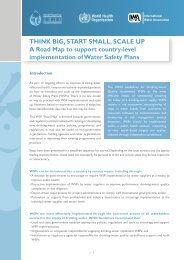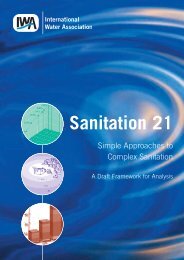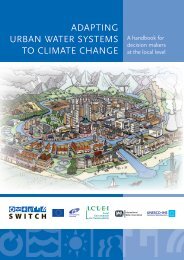Specialist Group on Use of Macrophytes in Water Pollution ... - IWA
Specialist Group on Use of Macrophytes in Water Pollution ... - IWA
Specialist Group on Use of Macrophytes in Water Pollution ... - IWA
You also want an ePaper? Increase the reach of your titles
YUMPU automatically turns print PDFs into web optimized ePapers that Google loves.
Collected samples were analysed for temperature, pH, c<strong>on</strong>ductivity, total dissolved solids,<br />
redox potential, dissolved oxygen, suspended solids (SS), and chemical oxygen demand<br />
(COD) at The University <strong>of</strong> Ed<strong>in</strong>burgh. Amm<strong>on</strong>ia-nitrogen, nitrate-nitrogen, nitrite-nitrogen,<br />
total organic nitrogen, chloride, and molybdate reactive phosphorus (MRP, equivalent to<br />
soluble reactive phosphorus) were tested at the <strong>Water</strong>ford County Council water laboratory.<br />
Figure 3. Integrated c<strong>on</strong>structed wetland near <strong>Water</strong>ford (Ireland); a: ICW site 11 treat<strong>in</strong>g<br />
farmyard run<strong>of</strong>f; b: ICW site 7 treat<strong>in</strong>g domestic wastewater.<br />
RESULTS<br />
<strong>Water</strong> treatment performance<br />
In this study, experiments were carried out <strong>in</strong> five column-scale horiz<strong>on</strong>tal free surface flow<br />
ICW systems. Mesocosms 1 and 2 were c<strong>on</strong>ducted between February 2009 and October<br />
2010. Whereas mesocosms 3, 4 and 5 were operated between May 2009 and October 2010.<br />
These results <strong>in</strong>dicate that the mesocosms act as sources <strong>of</strong> COD rather than as s<strong>in</strong>ks (Figures<br />
4 and 5). The sediments released substantially more organic matter <strong>in</strong> comparis<strong>on</strong> to the<br />
amount <strong>of</strong> <strong>in</strong>com<strong>in</strong>g organic matter that could be degraded. This can be expla<strong>in</strong>ed by the fact<br />
that most organic matter accumulated at the <strong>in</strong>terface between the sediment and clay layers<br />
due to the characteristics <strong>of</strong> slow organic matter decompositi<strong>on</strong> and low permeability. In<br />
additi<strong>on</strong>, due to relatively high c<strong>on</strong>centrati<strong>on</strong>s <strong>of</strong> amm<strong>on</strong>ia-nitrogen <strong>in</strong> <strong>in</strong>fluent, more than<br />
90% <strong>of</strong> the above-ground plants <strong>in</strong> mesocosms were dead after operati<strong>on</strong> <strong>of</strong> approximately<br />
three m<strong>on</strong>ths. This change <strong>in</strong> plant presence c<strong>on</strong>siderably affected the oxygen transfer<br />
capacity to the deeper sediment layers and aerobic decompositi<strong>on</strong> processes were thus<br />
reduced. Therefore, the decompositi<strong>on</strong> rate was most likely slower than the primary<br />
productivity rate, which resulted <strong>in</strong> a net accumulati<strong>on</strong> <strong>of</strong> organic matter.<br />
In general, the amm<strong>on</strong>ia-nitrogen c<strong>on</strong>centrati<strong>on</strong>s at sampl<strong>in</strong>g po<strong>in</strong>ts for all mesocosms were<br />
relatively higher than that <strong>of</strong> <strong>in</strong>fluent, <strong>in</strong> particular at tap III (Figures 4 and 5). This is<br />
probably because accumulated amm<strong>on</strong>ia-nitrogen is bound loosely to the substrate such as<br />
sediment and subsequently released when water chemistry and other envir<strong>on</strong>mental factors<br />
change (e.g. oxygen shortage, low pH and temperature values, and high sal<strong>in</strong>ity<br />
c<strong>on</strong>centrati<strong>on</strong>). In additi<strong>on</strong>, k<strong>in</strong>etic amm<strong>on</strong>ificati<strong>on</strong> (m<strong>in</strong>eralizati<strong>on</strong>) <strong>of</strong> organic nitrogen<br />
proceeds more rapidly than nitrificati<strong>on</strong>, thus creat<strong>in</strong>g the potential for an <strong>in</strong>crease <strong>in</strong><br />
____________________________________________________________________________________________________<br />
<strong>IWA</strong> <str<strong>on</strong>g>Specialist</str<strong>on</strong>g> <str<strong>on</strong>g>Group</str<strong>on</strong>g> <strong>on</strong> <strong>Use</strong> <strong>of</strong> <strong>Macrophytes</strong> <strong>in</strong> <strong>Water</strong> Polluti<strong>on</strong> C<strong>on</strong>trol: Newsletter No. 38 19

















